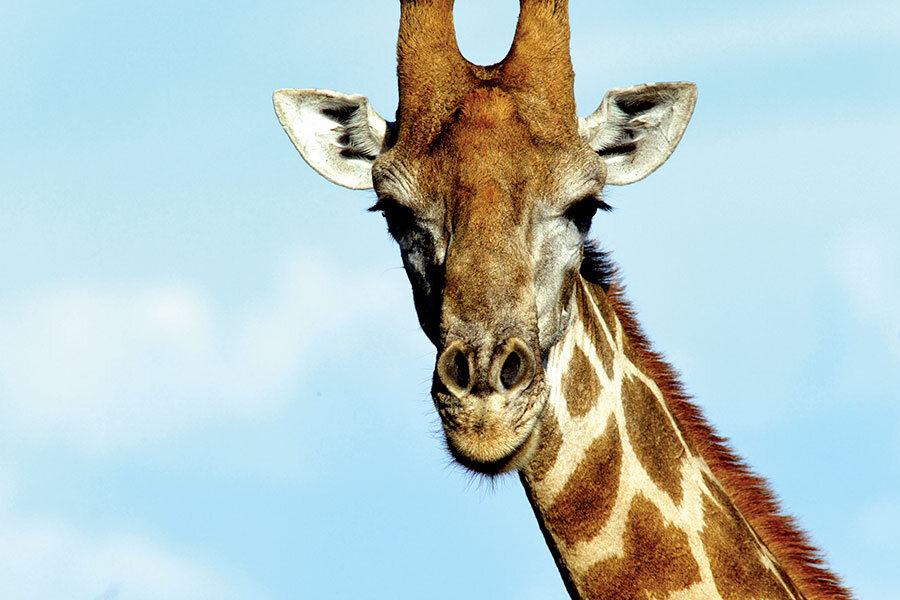An African desert teems with life
Loading...
It’s July in Namibia, and I’m as cold as I’ve ever been in a tent.
In the morning we’ll wake to find the water in the camp toilet has frozen, but now it’s the middle of the night and Steve is nudging me awake. “There’s something out there!”
“Is it a person?” I murmur sleepily.
“No. That would be crazy,” he replies. His reasoned patience is reassuring. Even in my groggy state, I know he’s right. We’re deep in the desert and haven’t seen a single person since leaving Windhoek, Namibia, early that morning.
“Listen! It’s an animal!”
And I hear it. From somewhere nearby comes a low, rubbery sound.
Gunk, gunk, gunk.
I can’t place it and, exhausted, feeling safe from carnivores in the rooftop tent, I bury myself under the covers and fall back asleep.
The next day’s sunrise paints the desert more shades of pink than we knew existed. We’re alone, surrounded by sand and scrub as far as we can see. It’s our first morning in the African wilderness, and we’re as giddy as children.
At breakfast we’re astounded as gemsbok approach to drink from a waterhole we hadn’t known was next to our campsite. We watch, delighted, as they seem to just materialize. A mother and juvenile bend to drink, keeping their eyes on us. Another spends minutes clearing the waterhole of small birds, clearly annoyed by the tiny avian army. Two young males strut, prance, and run around the tent, looking over their shoulders to see if we’re watching.
We are. We’re mesmerized.
I turn to Steve: “If we see nothing else in Africa, this is enough.”
We set off on a game drive later that morning, and the bounty of the desert reveals itself again and again. We came to the Namib because of our love of the dry, elemental, empty places of the earth. Unlike mountain landscapes, which are better viewed as vistas and lose dimension and scale up close, the desert demands intimate engagement. The land is etched with beauty, from the echo of water in the rippling patterns of the sand to the nearly microscopic beetle tracks we notice before they’re erased by the wind.
Everywhere, there is life: more gemsbok; then smaller springbok, cousins to the antelope at home. Farther along are herds of skittish zebra. I photograph a hartebeest carcass half obscured by the sand and later spot the herd from which it must have come – strange, doleful-looking animals. Hawks and secretary birds fill the trees and stroll the desert floor.
Two ostriches spot the truck and, wings outstretched in terror, run madly parallel to the road before veering off away from us.
Steve crests the truck over a hill and suddenly brakes hard.
“Whoa. Whoa! It’s a giraffe!”
And there, there: A juvenile giraffe, just off the left front fender, is browsing among the thorn bushes and blending almost perfectly into the red and white landscape. It is the animal I had most hoped to see but did not expect to find in the desert.
“Oh! Oh, a giraffe!” The words come out less like an exclamation than a sigh.
We watch as it crosses the road in front of us, marveling when it nearly disappears in the dappled shade of the acacia trees. Looking behind us we spy its mother. She had been placidly observing us long before we knew she was there.
We return to camp that afternoon and the game warden arrives to welcome us to the desert. He listens as we breathlessly recount everything we’ve seen and seems genuinely amused when we tell him that this one day – our first day in the Namib – has made the whole trip perfect.
He congratulates us on seeing giraffes, then examines tracks in the sand around the tent site: huge prints we mistook for gemsbok. “Ah yes,” he says. “It looks as though they visited you here.”
We stare in awe at the heart-shaped prints and the bits of acacia leaves around them, evidence of a midnight snack. The gunk, gunk, gunk of the previous night comes back to me. Giraffe vocalizations are too low for the human ear, but we likely heard them stripping leaves off the tree just feet from where we slept.
It is a wonder beyond reckoning. There, in the dry silence of the desert, surrounded by shifting sand and wind and sky, we are awestruck at a world that can hold such magic as giraffes.
It is more than enough.







